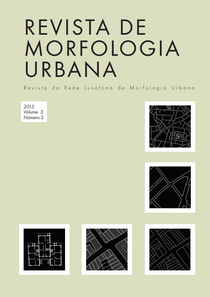Abstract
This paper gathers research, developed in 2012/2013, in which urban morphology was used as an investigating tool to study the relations between urbanization and development, producing a comparative study of spatial and economic development, planning processes and the resulting urban forms of four cities: São Paulo and Jakarta, and Hanoi and Belo Horizonte. Planning policies and urban forms were compared at different scales in these four cities, using the approach proposed by Lamas (1993). São Paulo and Jakarta were chosen due to their importance and economic relevance on their respective contexts, Latin America and South East Asia, offering the possibility of comparison aiming at finding relevant similarities. Hanoi and Belo Horizonte have similar positions regarding their contexts; both are administrative cities with similar characteristics in terms of demography, economic growth and rapid urbanization. Despite these similarities, the cities present distinct processes of growth and urbanization, as well as cultural aspects; both were highlighted in this comparison. This study investigates the patterns of urban form of these four cities, exploring their urban tissues and building types, aiming at a better understanding on how these cities have coped with economic processes and how they work today, opening the possibility of broader discussions on which lessons can be drawn both to these case studies and to cities in general.
References
Amorim, F. (2007) ‘Belvedere III: um estudo sobre as influências do mercado imobiliário na produção da paisagem e espaços urbanos’, Tese de Mestrado não publicada, Universidade Federal do Rio de Janeiro, Brasil.
Barbosa, E. R. Q. (2011) ‘Sao Paulo today, Hanoi tomorrow? Landscape urbanism to prevent parallelisms in the contemporary southern city’, Tese de Mestrado não publicada, Universiteit Katholieke Leuven, Bélgica.
Barbosa, E. R. Q., Fernandes, P. C. A. e Tú, N. T. (2013) ‘Urbanization processes and urban morphology in the periphery of capitalism: São Paulo, Jakarta, Hanoi and Belo Horizonte’, Global Development Network Working Papers 76, 1-138.
Costa, H. S. M. (2006) Novas periferias metropolitanas (C/Arte, Belo Horizonte).
Lamas, J. M. R. G. (1993) Morfologia urbana e desenho da cidade (Fundação Calouste Gulbenkian / Junta Nacional de Investigação Científica e Tecnológica, Lisboa).
McFarlane, C. (2010) ‘The comparative city: knowledge, learning, urbanism’, International Journal of Urban and Regional Research 34, 725-42.
Padiá, V. (2013) ‘Heliópolis: as intervenções públicas e as transformações na forma urbana da favela (1970-2011)’, Tese de Mestrado não publicada, Universidade Mackenzie, Brasil.
Santoso, J. (2009) The fifth layer of Jakarta (Graduate Program of Urban Planning Centropoli, Jakarta).
Solà-Morales, M. (1997) Las formas de crecimiento urbano (Ediciones UPC, Barcelona).
Somekh, N. (1987) ‘A (des)verticalização de São Paulo’, Tese de Mestrado não publicada, Universidade de São Paulo, Brasil.
Venturi, R., Brown, D. S. e Izenour, S. (1977) Learning from Las Vegas: the forgotten symbolism of architectural form (MIT Press, Cambridge).
Villaça, F. (2001). Espaço intra-urbano no Brasil (Studio nobel, São Paulo).
Waisman, M. (2013) O interior da história (Perspectiva, São Paulo).
Os direitos autorais permanecem com os autores, que autorizam a Revista de Morfologia Urbana a publicar o artigo sob uma licença Creative Commons Atribuição (CC-By).


